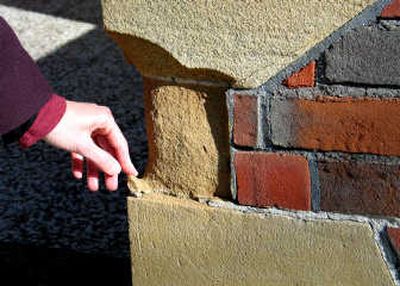Historic home needs repairs

Architectural sandstone that supports the corners and walls of Spokane’s historic Campbell House has been crumbling from age, and curators are looking for ways to repair it.
The soft stone appears to be susceptible to damage from water as well as other environmental forces. Large sections of some of the stones have fallen away, and other pieces have been patched. Some of the worst damage is found along stones that support piers to the front porch. The wear to the sandstone is not considered a threat to the public showplace on the grounds of the Northwest Museum of Arts and Culture.
“It’s time-age damage,” said Randy Sadberry, facilities manager at the MAC.
Last month, the museum obtained a certificate of appropriateness from the Spokane County/City Historic Landmarks Commission to implement needed repairs at the English Tudor Revival house.
The museum has hired an architect and an engineering firm to ensure that the work does not cause any additional problems. The museum plans to place new mortar along joints where mortar has fallen away; patch stones that have eroded; and take steps to keep the stone as dry as possible.
Maintaining sandstone is a common problem because the natural forces that created the stone also left it susceptible to deterioration, according to a paper by the New York Landmarks Conservatory.
“This isn’t damage that’s happened in the last five years,” Sadberry said, but the maintenance is needed to keep the surfaces from getting worse. The work could occur later this year. In addition, some mortar joints between exterior bricks need replacing.
Sandstone used in the Campbell House is believed to have come from a mine near Tenino, Wash., said Patti Larkin, curator of the Campbell House. She said replacing damaged stone is a last resort.
Sandstone forms naturally as layers of sand and minerals are pressed into soft rock with a natural cementing agent. Sandstone typically has layers or strata that are called bedding planes. Those planes can be the site of weaknesses in the rock.
Patsy Clark’s Mansion, which also has architectural sandstone, has seen deterioration of the stone along its foundation because of a sealant that was applied to the surface years ago. A sealant put on the stone at the Campbell House has been taken off.
Such coatings are believed to trap moisture and migrating soluble salts within the stone, leading to flaking of the surface.
The 1898 Campbell House was built for Coeur d’Alene mining magnate Amasa Campbell and his wife, Grace. Their daughter, Helen, donated the home to the Eastern Washington State Historical Society in 1924 after the death of her mother. The house is maintained largely in its original condition with vintage furnishings. It is among a number of fine residential buildings designed by renowned architect Kirtland Cutter.
The Campbell House was placed on the National Register of Historic Places in 1974 and the Spokane register in 1987. It is included in the Browne’s Addition Historic District.